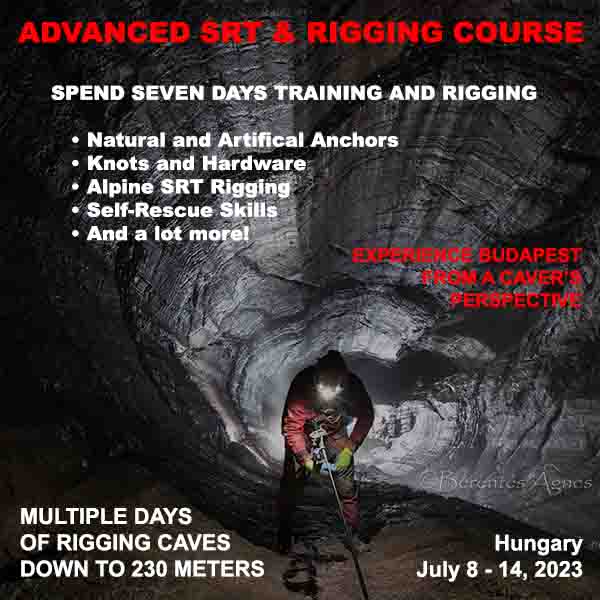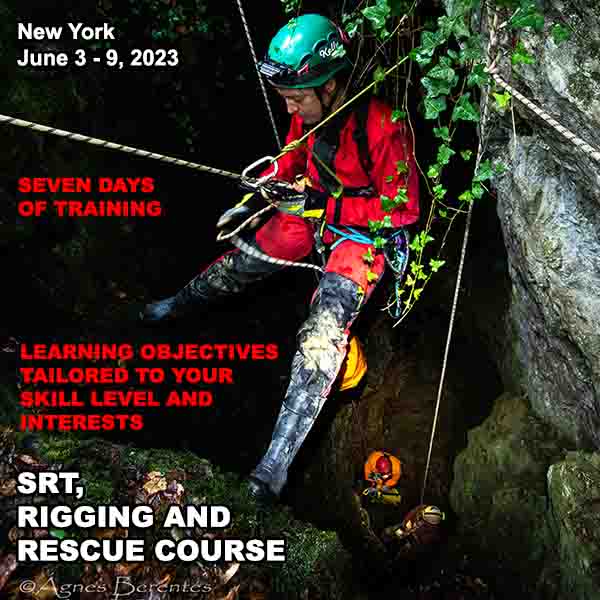
Horizontal Caver
Whether you are a new caver or want to refresh your knowledge, this course covers the fundamentals of caving to help build safe, strong, and effective explorers.
This course includes topics such as cave development, cave conservation, equipment selection, layering solutions, food and liquids, emergency supplies, emergency call-outs, safe caving practices and navigation. Next are in-cave experiences designed to provide systematic hazard evaluation, good decision making, and safe movement. The goal is to face progressively more challenging circumstances, such as scrambles, crawls, squeezes, chimneys, and exposures (with hand lines). There will also be discussions of what to do during different types of emergencies.
Available in 1-day or 2-day schedules and tailored to the local cave environment, the course may optionally include belayed movements, cable ladders, in-cave map reading, route finding, and marking the way out of the cave, along with other topics of interest as time allows.

Basic Vertical Caver
Whether you are a new caver that wants to go straight to vertical caving, have been a horizontal caver and are ready for the transition, or have some existing knowledge but want to refine your skills, this course covers basic SRT (single rope technique).
This course covers topics such as ascending system selection, optimal system configuration, tuning a system for efficiency, what emergency equipment to carry, and proper communications. Skills learned include ascending, down-climbing, change-overs, lock-offs, and rappelling. Once basic movement on rope has been achieved in a free-hanging environment, the course will transition to negotiating edge transitions and operating in-cave.
Available in a 1-day or 2-day format, with the additional option of incorporating the intermediate material.

Intermediate Vertical Caver
While it is possible to effectively navigate American IRT style single drops with basic SRT skills, this course transitions your skillset from an American IRT approach to the more advanced alpine SRT, or European SRT. Complex vertical caves require complex rigging and your skills should match; and then you can apply your new expertise to all your caving, even basic pits.
This course includes navigating deviations, rebelays, mid-line knots, traverses, guidelines, j-hangs, and line-transfers. You will learn options for resolving your own on-rope system failures and emergencies, as well as options for providing basic assistance to others stuck on-rope.
Available in a 1-day or 2-day format, as well offered as part of an extended course when combined with the advanced material.

Advanced Vertical Caver
Being able to navigate efficiently and effectively on rope is a respectable goal, but being a rope ninja is really where it's at. This course will be about all the things you shouldn't do, don't want to do, or think you can do -- and having fun with it. We will throw the worst things we can at you so you've already faced and overcome them in a controlled training environment and you'll be more prepared for the unexpected when in-cave.
This course includes training on some horribly inefficient rigging, navigating painfully poor edge transitions, and moving on rope with the sheath damaged and even fully stripped. And through it all we will be right there with you offering techniques and tactics to handle it with style, efficiency, and hopefully ease by the time we are done. However, things do go wrong, and this course includes rescuing conscious and unconscious cavers when they are stuck on-rope.
We will also rig ropes with dynamometers so you can see just how soft you can climb and descend. Think you got good numbers and the unknown anchor at the top of an ancient dome-climb will hold? Of course it's no fun if you don't try to max forces too: stopping your rappel as fast as possible? How about the leg of an anchor failing? An entire rebelay? All done in a safe and controlled environment of course!
Available in a 2-day or 3-day format, as well as offered as part of extended courses when combined with other material.

Rigging Course
Scheduled Courses:
July 8th through 14th, 2023 in HungaryWhile the ability to travel on rope gives you mobility through a rigged cave, you'll only be able to follow someone else's path. Once you learn how to rig for yourself, then you can be the one leading the way. However, there is substantial responsibility associated with rigging as lives will depend on your judgement and skill.
This course includes topics such as the types and goals of rigging, types of anchors, knot selection, anchors versus anchor systems, optimizing your system to rig efficiently, preparing for a rigging trip, safety while rigging, bolting considerations, lead-climbing considerations, and bolts/anchors/rigging documentation. The course tries to maximize hands-on evaluation and personal experience with skills learned on-cliff and then quickly transitioning to in-cave experiences.
You will determine the safe zone, start an approach line, set rebelays, deviations, traverse lines, j-hangs, guidelines, and line-transfers. Learn to rescue someone who falls while they are rigging in a range of circumstances.

Trip Leader Course
While technical skills are important, leading a trip is not just about being a rope ninja or rigger. Managing people and keeping them safe while achieving trip objectives is not a simple task. Whether you are leading a first-time horizontal trip, taking experienced people on a sporting vertical trip, or pushing leads and surveying, getting out safe is the first priority. If you achieve the objectives while being well organized, minimizing issues, and with everyone happy, it's true success.

Bivying/Camping
From emergency bivies to long-term cave camps, this course focuses on overnights in a cave along with the range meal options. The standard curriculum is offered as a 1-night or a 2-night course with the style of the overnights based on the interest and needs of the class. Options include:
- improvised overnights from minimal gear,
- unplanned overnights using an "emergency cache",
- lightweight planned overnight stays,
- permanent underground camp arrangements, and
- hammock camping for the vertical environment.
The course will start by going over the critical factors involved in surviving an overnight and minimalistic solutions and then progressively add equipment and supplies that will make the situation more comfortable. There will be hands-on presentations of numerous options and solutions before going in-cave to implement the chosen overnight stay(s).
For a 2-night stay, it is suggested that the first night start as an improvised minimalistic solution, which transitions to a lightweight overnight. This will make the second night, which is coordinated as a planned camping situation, feel luxurious. The available daytime hours will be occupied with Caving Academy curriculum appropriate for the participants. There may also be an in-cave movie!

Expedition Management Course
Managing an expedition is a complex multi-faceted beast! So many obligations and responsibilities all vying for attention before, during, and even after the expedition. It's not a task that anyone envies, but it's one that everyone respects and appreciates when done well.





